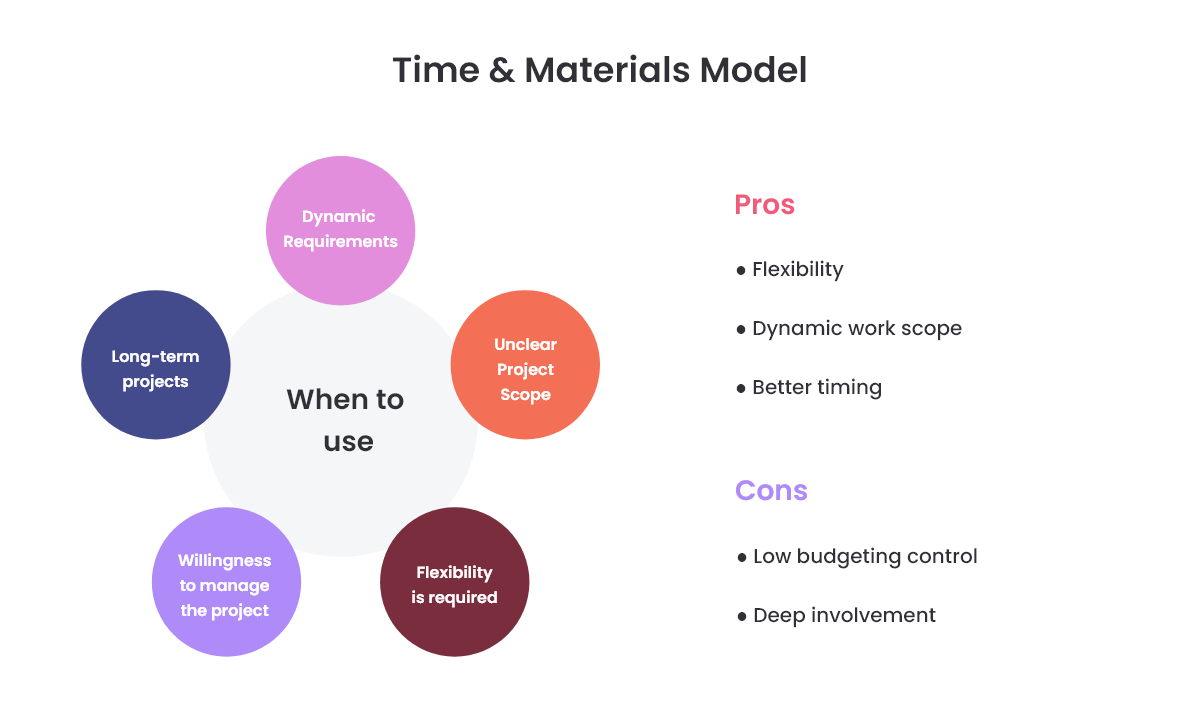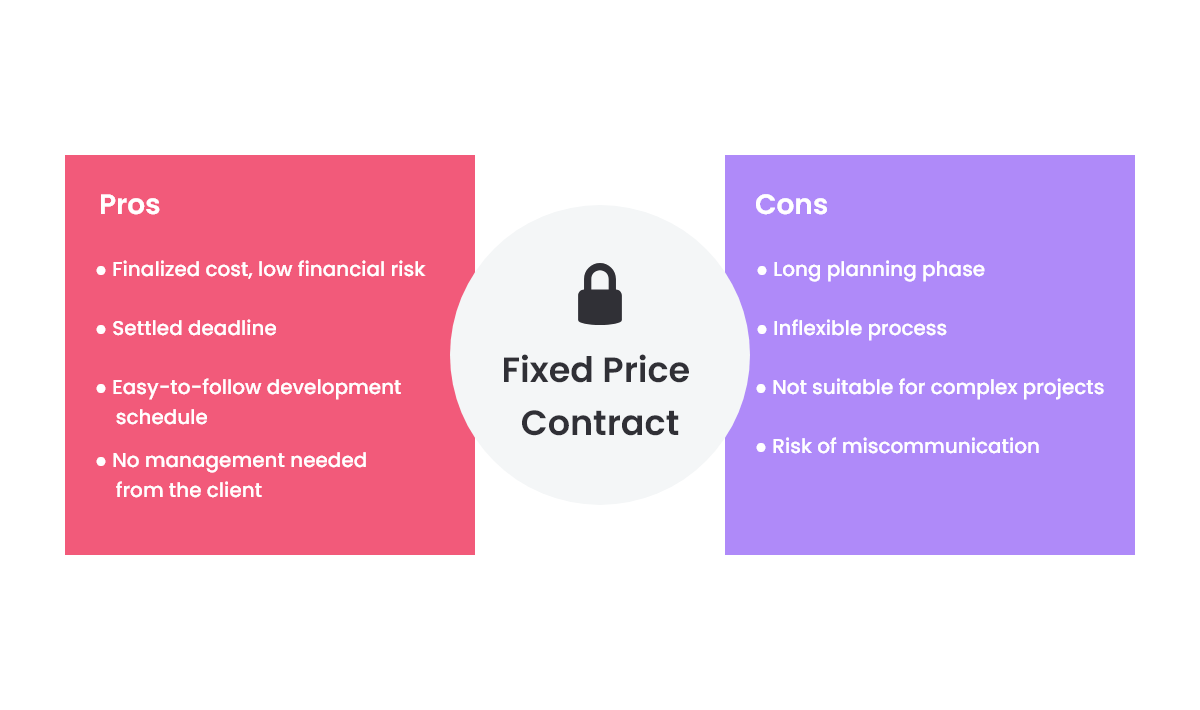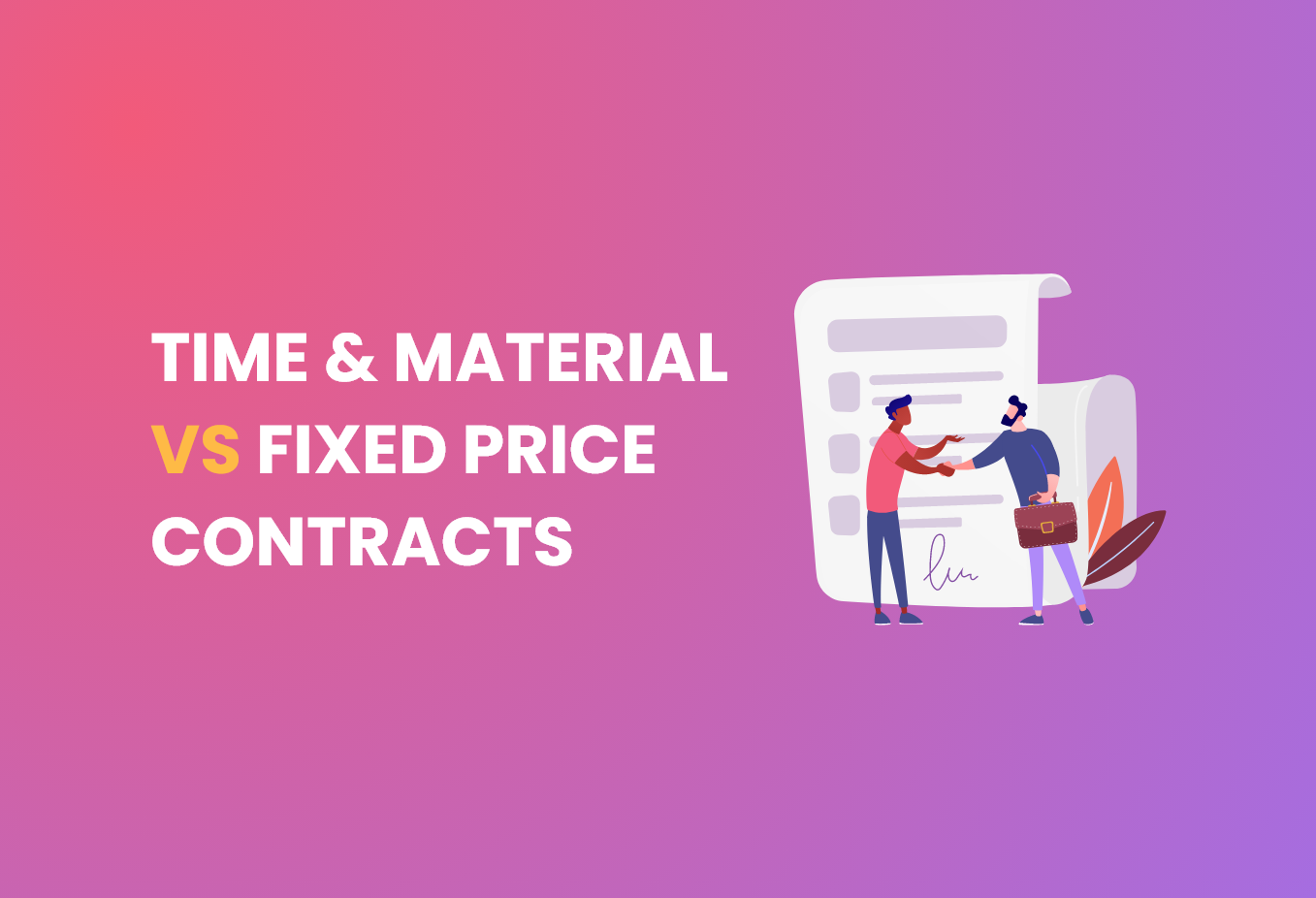Today’s article will discuss the advantages and disadvantages of time and material vs. fixed-price contracts, as well as their practical use in software development. Why? Because early outsourcing agreements were typically based on a fixed price model, another prevalent business model, time-and-materials, is also widely utilized. Choosing the best price contract may be a difficult task. And this is because it should be compatible with your company’s operational procedures, contractual needs, goals, etc.
Fixed-priced and time and materials are the most popular and time-tested software development pricing methods. It’s worth mentioning, though, that today’s businesses use hybrids and combinations of their own. Because software development isn’t cheap, budget is one of the most important considerations. Startups and small businesses who wish to invest in an app are searching for ways to save money wherever they can. Therefore, let’s see what we can find out. Which is better for your project: time and material vs. fixed price?

Time and Material VS. Fixed Price – the Differences
We must first define the features before we can compare time and material vs. fixed price contracts.
Time and Material contract (T&M)
This is the best approach to calculate how much time and resources the project will take. It’s especially useful when we can’t foresee whether or not the project will change over time or when we think it will.
When establishing an hourly cost for software development services, the Time and Materials contract analyzes several variables. And this may include things like each project participant’s compensation or the time and money spent on face-to-face meetings. It’s important to note that this contract covers project management, communication with the development team, and other tasks related to the product’s development and implementation.
When should you utilize the T&M pricing contract?
-
- Projects with a long timeline and changing needs
-
- The project’s scope is yet unknown.
-
- You want the freedom to change the scope or the workloads.
Fixed Price contract
As the name suggests, a fixed-price contract is an agreement in which the cost is unaffected by the usage of resources or the amount of time spent on the project. The client has to pay one fee to get the product. It’s a straightforward setup that reduces paperwork and negotiating time. Therefore, the fixed-price contract is the inverse of the T&M contract.
Based on their previous experience with comparable projects, the vendor sets the pricing. This may be a trap since each product is unique, making it difficult to estimate the precise amount of time and resources required. However, if the app, website, or other software has comparable characteristics to the developers’ previous work, they can typically offer a reasonable amount of money for the customer to pay.
When should you utilize a fixed-price contract:
-
- Specific criteria and deadlines
-
- Budget constraints or a restricted budget
-
- MVPs
-
- Small projects with a restricted scope of work
As can be seen, these two kinds of contracts are opposed. Time and material vs. fixed price contracts provide varying degrees of flexibility and are appropriate for a variety of needs. Now we can take a deeper look at who may profit from each pricing plan, as well as its advantages and disadvantages.
The Benefits and Drawbacks of a Time and Material Contract
This is Treinetic’s recommended pricing strategy. We welcome it since it addresses the client’s requirements as well as the budget. T&M provides you with a specialized team of experts that may be tailored to your specific needs. There is no issue with altering the course of your project and requires a new skill set or more programmers for whatever reason.
Pro: Better control over the project
The time and materials pricing approach is popular in Agile development because it allows the client to participate. This typically includes sprints, iterations, and frequent meetings to discuss progress and future actions.
Pro: Extreme adaptability to changing needs
The Time and Materials model allows for modifications and adjustments to the production process. If the client has a budget, adding, eliminating, and enhancing each feature to get the intended impact is not an issue.
Pro: A quicker project start and a more dynamic decision-making process
The project’s early launch will help a large number of entrepreneurs. They should also make choices while the development process is still in progress. This allows them to adapt to the requirements and pains of their target audience, which may change at any time.
Con: Uncertainty for the timeline
As this kind of contract is extremely flexible, disadvantages and problems may arise. The deadline may become a distant date in the indefinite future if we lose control of the project.
Cons: Less budgetary control
Work that is not constrained by a strict plan and timetable, as with a Fixed Price contract, implies that we may wind up paying considerably more than we intended. A solution to this problem would be to apply common sense and only request additional features to help our company. When calculating expenses, keep in mind that developers in different regions charge varying rates, as Statista demonstrates.
Con: The need to be much more involved
Time and Materials may not be ideal if the clients do not want to be a part of the team. It necessitates their presence and, in many cases, active involvement.

The Pros and Cons of a Fixed-Price Contract
Pro: Being certain about the cost
This price arrangement provides both parties with consistency, which may be advantageous for startups or small businesses with a flexible budget. They pay the agreed-upon amount and don’t have to worry about anything else. That may be risky for the software development company, but they receive some pay upfront, so it’s a win-win situation. However, if anything changes while they’re working on a project and need additional money, they won’t obtain it unless their client is willing to negotiate.
Pro: Established deadlines
Fixed-price contracts require careful preparation; every element must be taken into account when estimating prices. This method makes predicting how much work the project will take and when completed much simpler. This is critical for all clients who care about time-to-market.
Pro: No need to control the process
Clients who do not wish to be overly engaged in the work process may benefit from a Fixed Price contract. The first planning step provides a clear path for the development team to follow. The client does not need to have as much control over what is going on and may concentrate on other business operations.
Con: Longer preparations
According to GoodFirms, the average time to produce bespoke software is 4.5 months. However, as previously said, much preparation is needed to determine the most accurate pricing for the developed software. But when it comes to short deadlines, this may be a disadvantage. Even so, we may not be able to prevent certain communication misunderstandings while the project is continuing.
Con: Higher cost of the project
Because there will be no budget adjustments throughout the project, the software development firm must anticipate all possibilities and be prepared. To minimize risks, the price under the Fixed Price model should contain a reserve.
Con: Worse response to changing conditions
If the market scenario unexpectedly changes, the only option for modifications is within the budget, which may be limited given the previously stated strategy. Furthermore, if the client has an idea that would be far more useful to the company, it may be impossible to implement it under a Fixed Price contract.

Which Should I Choose: Fixed Price or Time and Material?
Both kinds of collaboration models have upsides and downsides. Therefore, they are best suited to certain projects. A Fixed-Price contract is a suitable choice if you have a small project with clear instructions or are certain that no modifications will be required. You will be aware of the project’s cost in advance, and your product will be produced on time. However, it would be best if you were prepared for unforeseen problems or mistakes that may cause you to miss the deadline, incur extra expenses, or leave you with an incomplete project.
A Time and Material contract might be a preferable option for bigger or longer-term projects. It provides product development freedom and control while also assisting you in staying under budget. However, since there is no exact end price or deadline date, you must keep track of the expenses and the project’s progress. T&M also requires regular communication between your team and the developers, so you’ll be spending a lot of time in meetings. Please get in touch with us if you are having difficulty selecting the appropriate model for your project. We can help you.

